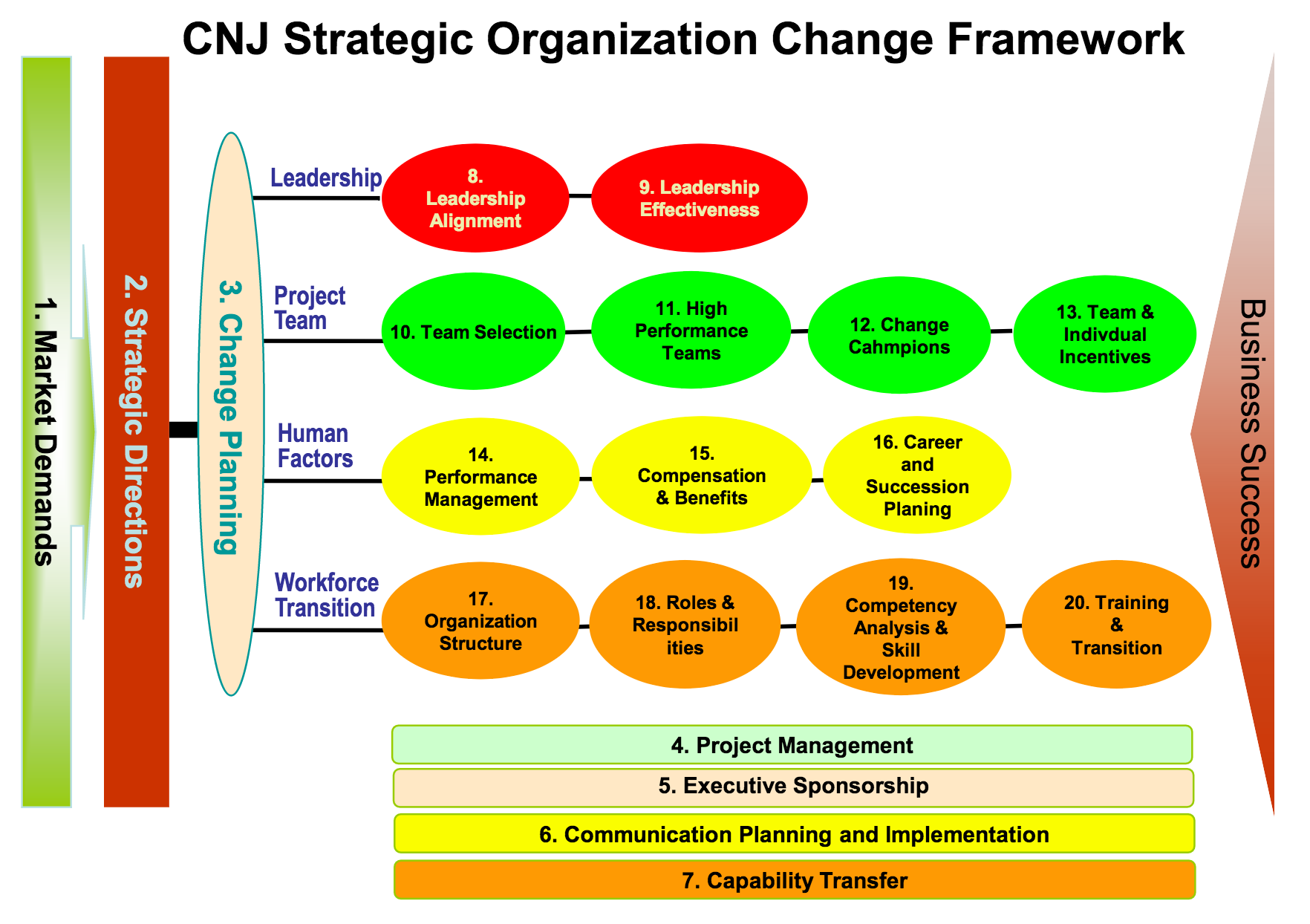CNJ Organization Change Framework leverages distinctive, insight-driven analytics and proven methods to increase the pace, certainty and successful outcomes of our clients’ organization change programs.


CNJ partners with our clients to:
- Envision, plan, and manage enterprise transformation programs.
- Plan and execute change management initiatives, with speed and agility.
- Build an internal change capability that is increasingly agile and adaptive.
- Use predictive analytics in decision making and highlight paths that will help achieve desired business outcomes during change for better business in the market.
Our integrated focus on organization transformation, change management and change capability building—supported by CNJ Change Framework—is an approach to organization change that is clearly differentiated in the US marketplace.
CNJ Organization Change can enable Korean companies to manage change with precision and more predictable results, at a pace that is faster and more effective than their competitors.
Change comes to business in many forms: merger, acquisition, divestiture, joint venture, new leadership, technology implementation, organizational restructuring or regulatory compliance. But the same central challenges apply almost every time: communication, culture, change management, and ultimately diversity alignment. Korean entrepreneurs have to reach agreement on priorities, direction and organizational culture, then communicate this vision to employees along with the specific steps necessary to make it a reality.
Easy to change hardware, difficult to change software
Even if a company acknowledges the “soft” change management needs that accompany a “hard” change in system or structure, it’s easy to lose focus on them. When a company is consumed with getting the business aspects of the change right, the change management agenda may be the first thing to fall off the radar screen – or the budget. But it’s often the first thing to come up in a post-project accounting of things that should have been done better.
Whether a company is changing its business tools, answering to new leaders or transforming its culture, managing the communication and transition process proactively is extremely important. Job security is employees’ number one concern when the company goes through large-scale change like mergers and acquisitions. Strategic communication can help retain top performers, ease employees’ concerns, and maintain “business as usual.” It’s important not only to put people at ease and retain top talent, but also to help everyone understand the nature, demands and rewards of the changing roles they’ll play for their success.

How CNJ can help
CNJ realizes the importance of combining deep strategic change experience with practical business strategy. CNJ has an array of tools and resources that help Korean companies deliver strategic change. The best change strategy, however, is the one that meshes leading practices with our clients’ specific needs.
To better know those needs, CNJ employs proven tools, collectively called the CNJ toolkits, to sound out and integrate the strategic priorities that arise from different parts of our client company and to assess an organization’s current state, define an ideal state and measure the gaps to be overcome.
- Leadership alignment
- Change readiness assessment
- Change impact assessment
- Workforce transition
- Change communication
- Organization infrastructure re-design
- Organization Culture assessment
- Future-state culture visioning workshop
- Targeted behavior change for business critical events
- Recommended solutions to achieve cultural transformation
- Stakeholder analysis
- Communication strategy and plan
- Leadership communications
- Written communications
- Site enrollment
An effective strategic change strategy can help an organization in its efforts to:
- Recoup the initial investment in the infrastructure by fostering successful employee adoption
- Reduce the learning curve associated with a major transformation to achieve full productivity sooner
- Recoup the investment made for a merger & acquisition by preventing decreased morale, low productivity, and employee turnover
- Retain top performers through strategic communication and a managed change experience
- Identify risks associated with a business transformation ahead of time and address them before implementation
CNJ Ways to Show How to Change YOUR Organizational Productivity
Whether the starting point is a crisis or an opportunity, people drive all successful transformations. Here are some principles CNJ has learned after helping a long list of sizable organizations effectively successfully manage change:
Identify sponsor(s) who will show visible commitment to change.
Identify the most appropriate leader or leaders who will visibly and actively demonstrate commitment and champion the change.
Influence the influencers.
Identify people within each stakeholder group who command the most respect and then get them involved as champions for the organization change.
Demonstrate incremental progress and successes.
Communicate critical milestones and project successes throughout implementation, watch expectations – and avoid overpromising or overselling.
Let people know how it will affect them.
As soon as you can answer this question, share the answer – tell people what’s going to happen, good or bad, so they can be prepared. Recognize that people’s past experiences with change will color their perceptions about what you’re trying to accomplish today.
Align culture with strategy.
Culture and business strategy should reflect each other and should foster the behaviors that lead to success. Metrics and rewards must measure and motivate the desired behaviors.
Recognize there may be satisfied and dissatisfied.
The impact of organizational changes varies from one stakeholder group to the next, and some may not be happy with the outcome. Communications should be honest and direct, focusing on the positives, if applicable.
Establish governance.
To ensure a strong project management culture, project decision making and governance processes must be clearly defined and involve key leaders.

